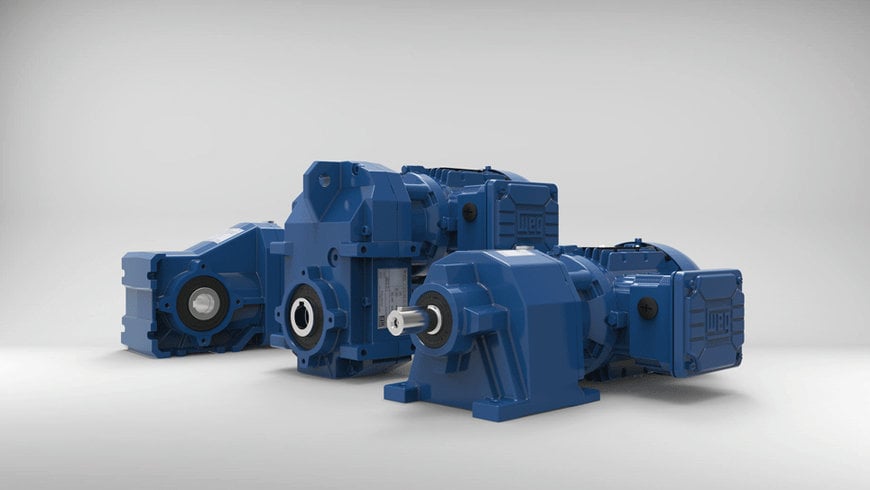www.industry-asia-pacific.com
18
'23
Written on Modified on
Weg can now Specify a gear unit
Industrial gears are essential for transferring power and motion, but design and specification is more diverse. Marek Lukaszczyk, Europe and Middle East marketing manager for geared motor manufacturer, WEG, explains how to specify the correct gear unit for your application.

Gear units are used to transfer power and motion between two elements, usually a motor and a machine, allowing the two to operate in a coordinated fashion. They are used for providing precise control, reducing noise or vibration and increasing efficiency.
Today’s extensive range of gear units mean that they come in many shapes and sizes and can be made from a range of materials. Not to mention, they can be designed specifically for varying industry applications, including robotics, automotive and aerospace, as well as for use inside other industrial machinery. The correct choice of gear unit can vary depending on the end goal.
Choosing the wrong gear unit can have a whole host of consequences. It can lead to excessive energy consumption, noise, wear and tear, reduced efficiency, and in some instances, breakdowns that lead to downtime of production. In some cases, the wrong gear unit can even lead to safety issues caused by consequences like excessive vibrations.
It is crucial that design engineers and operators take the time to research and select the right gear unit for each application, to ensure the best possible performance. But, where to start?
First, let’s start with the basics
Defining technical requirements is fundamental for choosing the right gear unit. The more clearly defined, the better. After all, if the wrong gear is selected — for instance if it is oversized or undersized, or has an insufficient lifespan in the application — it can cost the end user more in energy and cost in the long term.
The absolute basics of this technical specification include: the output torque required to complete the task, the speed and power requirements of the motor and the required mounting dimensions. Before a buyer makes a purchasing decision, the technical specifications must be checked by the company‘s own engineers. This is the only way to ensure that the gear units actually deliver the required power, reliability and cost-effectiveness in a specific application.
From a technical point of view, two factors are decisive when selecting a gear unit: the application requirements and the available space. This always depends on the location of the gear unit. Only if these two factors are fully known can the right gear unit be selected.
Gear drives are the most commonly used type of gear unit in industry, but there are other varieties to consider. Helical gear, bevel gear, parallel shaft gear and worm gear units make up the majority of all installed gears, and planetary gears are also used to a lesser extent.
Design differs depending on the industry in which the geared motors are to be used. Factors such as power (kW), speed (rpm) and torque (Nm) always influence size and cost. If a geared motor — what I mean by this, is the combination of motor and gear unit — is incorrectly dimensioned, it will have a negative consequence on the systems performance.
What are the conditions?
Once the basics are specified, an engineer should consider the ambient conditions in which the unit will operate. What installation space or room is available and where will the gear unit be installed? In some industries, like those operating in hazardous areas, considerations like excess dirt and dust, temperatures and explosive atmospheres should also be assessed.
Additionally, the user must consider what geographical region the unit will ultimately be operating in. Different certifications may be required, so opting for a unit that is CE (Europe), CSA (United States and Canada), UL and EA (both global) certified can be advantageous. WEG’s WG20 range of gear units — the first gear unit designed entirely in-house by WEG — meets this global certification, has standard mounting dimensions and can be switched to different voltages for applications around the world.
Efficiency requirements
Since gear units in industry are primarily used in combination with electric motors, efficiency also plays an important role in the selection of gear units. High efficiency can also reduce the operating costs and CO2 emissions of drives which — in today’s manufacturing landscape, where the industry is experiencing exceptionally high energy costs — can be colossal. In fact, energy costs account for almost 90 per cent of the total life cycle costs of geared motors, making efficiency a critical matter.
Investments in energy-efficient gear units generally pay for themselves in a relatively short period of time. This is not only important for an engineer or operator, but also for machine builders and original equipment manufacturers (OEMs). The following applies: the more efficient the entire drive train, the more economical it will be. This, in turn, can be passed on to the end customer as a financially beneficial sales argument.
Expert advice
As a global equipment manufacturer, WEG is well versed in helping engineers specify industrial equipment like gearboxes and geared motors. The company has published a series of guides on the topic, including What mechanical engineers and plant operators need to know when buying geared motors, a free to download gear purchasing guide.
www.weg.com

